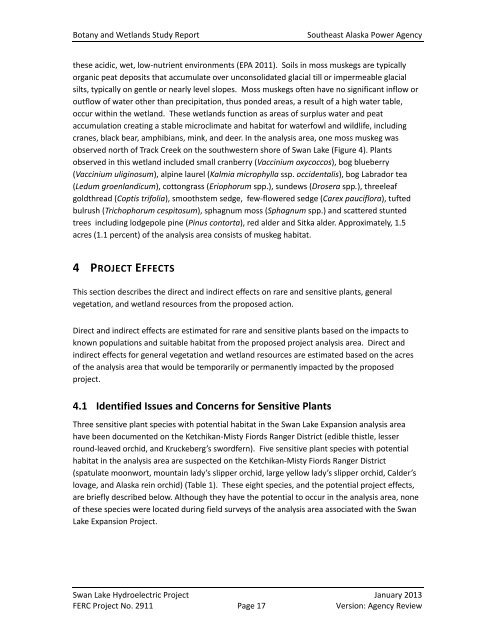Botany and Wetlands Study Report - McMillen, LLC
Botany and Wetlands Study Report - McMillen, LLC
Botany and Wetlands Study Report - McMillen, LLC
You also want an ePaper? Increase the reach of your titles
YUMPU automatically turns print PDFs into web optimized ePapers that Google loves.
<strong>Botany</strong> <strong>and</strong> Wetl<strong>and</strong>s <strong>Study</strong> <strong>Report</strong>Southeast Alaska Power Agencythese acidic, wet, low‐nutrient environments (EPA 2011). Soils in moss muskegs are typicallyorganic peat deposits that accumulate over unconsolidated glacial till or impermeable glacialsilts, typically on gentle or nearly level slopes. Moss muskegs often have no significant inflow oroutflow of water other than precipitation, thus ponded areas, a result of a high water table,occur within the wetl<strong>and</strong>. These wetl<strong>and</strong>s function as areas of surplus water <strong>and</strong> peataccumulation creating a stable microclimate <strong>and</strong> habitat for waterfowl <strong>and</strong> wildlife, includingcranes, black bear, amphibians, mink, <strong>and</strong> deer. In the analysis area, one moss muskeg wasobserved north of Track Creek on the southwestern shore of Swan Lake (Figure 4). Plantsobserved in this wetl<strong>and</strong> included small cranberry (Vaccinium oxycoccos), bog blueberry(Vaccinium uliginosum), alpine laurel (Kalmia microphylla ssp. occidentalis), bog Labrador tea(Ledum groenl<strong>and</strong>icum), cottongrass (Eriophorum spp.), sundews (Drosera spp.), threeleafgoldthread (Coptis trifolia), smoothstem sedge, few‐flowered sedge (Carex pauciflora), tuftedbulrush (Trichophorum cespitosum), sphagnum moss (Sphagnum spp.) <strong>and</strong> scattered stuntedtrees including lodgepole pine (Pinus contorta), red alder <strong>and</strong> Sitka alder. Approximately, 1.5acres (1.1 percent) of the analysis area consists of muskeg habitat.4 PROJECT EFFECTSThis section describes the direct <strong>and</strong> indirect effects on rare <strong>and</strong> sensitive plants, generalvegetation, <strong>and</strong> wetl<strong>and</strong> resources from the proposed action.Direct <strong>and</strong> indirect effects are estimated for rare <strong>and</strong> sensitive plants based on the impacts toknown populations <strong>and</strong> suitable habitat from the proposed project analysis area. Direct <strong>and</strong>indirect effects for general vegetation <strong>and</strong> wetl<strong>and</strong> resources are estimated based on the acresof the analysis area that would be temporarily or permanently impacted by the proposedproject.4.1 Identified Issues <strong>and</strong> Concerns for Sensitive PlantsThree sensitive plant species with potential habitat in the Swan Lake Expansion analysis areahave been documented on the Ketchikan‐Misty Fiords Ranger District (edible thistle, lesserround‐leaved orchid, <strong>and</strong> Kruckeberg’s swordfern). Five sensitive plant species with potentialhabitat in the analysis area are suspected on the Ketchikan‐Misty Fiords Ranger District(spatulate moonwort, mountain lady’s slipper orchid, large yellow lady’s slipper orchid, Calder’slovage, <strong>and</strong> Alaska rein orchid) (Table 1). These eight species, <strong>and</strong> the potential project effects,are briefly described below. Although they have the potential to occur in the analysis area, noneof these species were located during field surveys of the analysis area associated with the SwanLake Expansion Project.Swan Lake Hydroelectric Project January 2013FERC Project No. 2911 Page 17 Version: Agency Review


